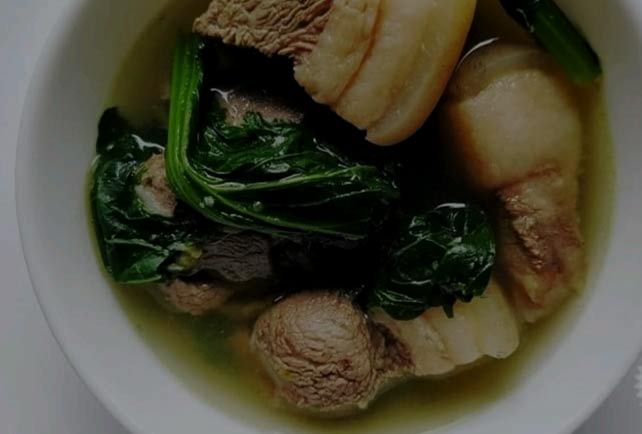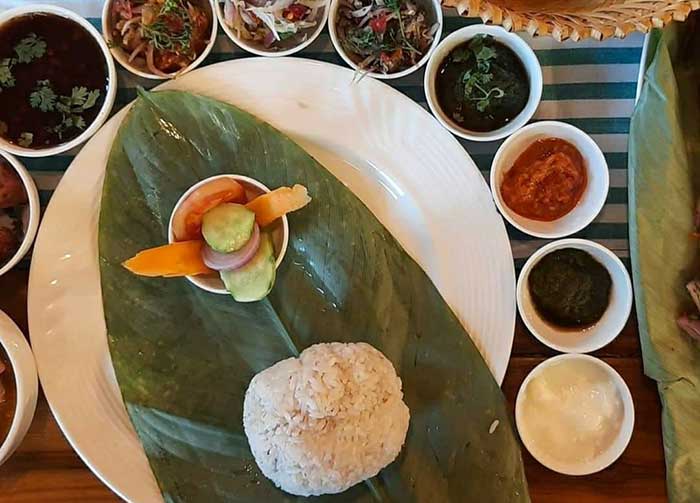Assamese cuisine is distinct for its ability to taste good despite the usage of minimal spices and oil. Its earthy and rustic scent is truly inviting to all food lovers. Even if you have Assamese food in a restaurant, you will never feel like you are outside. The homeliness of Assamese cuisine is undeniable.
Nonetheless, it is also quite unexplored by the mainlanders. If you plunge into the sea of knowledge, you’ll discover that Assamese cuisine is way more than “Aloo Pitika”, “Bhoot Jolokia”, and “Pork with Bamboo Shoots”.
Main elements of Assamese Cuisine

A mouth-watering Thali full of Assamese delicacies
Like all other cuisines in the world, the Assamese cuisine is reflective of the culture, tradition, and lifestyle of the local inhabitants of Assam. An Assamese thali is mostly composed of simple dishes made with local ingredients. The taste is very subtle and there is a homely feel to it. Almost all ingredients are locally available.
As rice is the staple food of Assam, it is also the primary item in an Assamese thali. Wheat was never grown in Assam, which is why it never became part of the Assamese thali. Even now, the majority of Assamese people do not consume wheat on a daily basis. An Assamese thali is a very healthy ensemble of vegetarian and non-vegetarian dishes. Irrespective of your preference, you will surely find something that you will love.
Although many dishes of Assamese cuisine are oil-free, Mustard oil is extensively used to prepare other dishes. The true essence of Assamese food comes out when pure mustard oil is used. The local people say that opening the bottle must release a strong tear-inducing pungent scent. The usage of refined oil, ghee, butter, etc is optional. They were not used traditionally. Most importantly, they do not compliment the taste of the ingredients.
The spices used in Assamese cuisine are not like other parts of India. Dry spices are used mostly while cooking non-vegetarian food. In the majority of other dishes, ground garlic-ginger paste, fresh leaves of coriander, aromatic leaves of certain herbs, etc are enough. Assamese cuisine also makes use of fermented ingredients such as fermented bamboo shoots (Khorisa), Fermented Mustard seeds (Pani Tenga), Fermented fish (Hukoti), etc.
But what makes Assamese cuisine interesting is that it is incomplete without Ghost Pepper, which is locally known as “Bhoot Jolokia” or “Bee Jolokia”. This pepper is very known to have many health benefits. People either eat it raw or in pickled form while having meals.
Two more special ingredients are Elephant Apple and Kazi Nemu. Elephant Apple is locally known as “O Tenga”. Although it has “Apple” in its name, it is a sour ingredient. It is extensively used while cooking dal, fish, etc. Kazi Nemu is a type of lemon, which is extremely juicy and fragrant. People use it while cooking or have it as a condiment.
Apart from these, there will be some form of green leafy vegetable in an Assamese thali for sure. Assamese people eat healthily and a lot of green leafy vegetables are consumed by them throughout the year. Different seasons allow the consumption of different vegetables and people are happy to relish them anytime.
14 Unique and Delicious traditional dishes in Assamese Cuisine to try at least once

A bowl of boiled pork cooked with lettuce leaves
The variety of Assamese food is huge. It is impossible to cover everything about Assamese cuisine in one blog. One whole blog can be dedicated to Assamese cuisine, food, and culture. However, if you are curious about where to start, we are listing down 14 Unique and Delicious traditional Assamese dishes to try at least once in a lifetime.
1. Omita Khaar
Omita Khaar is made out of unripe papaya mixed with Kaar. Khaar is an alkaline solution prepared by burning dried banana leaves and mixing the ash with water. This is used as a palate cleanser and is very good for the stomach. It is the first thing to be eaten from the Assamese thali.
2. Fried Fiddlehead Fern with Elephant Apple (Dhekia with O Tenga bhaji)
Fiddlehead Fern tastes good on its own. But when it is combined with thinly sliced Elephant Apple, it becomes tastier. The primary taste would be sour, but the intensity depends on the amount of Elephant Apple used. It is good to use that in moderation to get the best taste. Other ingredients include onion, pure mustard oil, salt, and a pinch of turmeric powder.
3. Banana Flower with Chicken/Duck Meat
Banana Flower is rich in iron and other vital nutrients. To make it even healthier, you can combine it with chicken or duck meat. It tastes great, depending on the culinary skills of the cook. It does take some effort to make it taste really delectable. The dish is supposed to be just moist and not soupy.
4. Duck Meat with Ash Guard
Ash guard is locally known as Joha Kumura and is very dear to the Assamese people. Joha Kumura is different from the Pani Kumura due to the distinctive scent it has, similar to Joha rice. When cooked with duck meat, it can surely drive your taste buds crazy. Assamese people love it. It can be cooked both in a dry form or in a stewy form.
5. Spinach and Small Fish curry with Elephant Apple
There is truly no comparison to this humble dish made out of three primary ingredients. This combo is absolutely loved by the Assamese people. The curry is very light and delicious.
6. Roasted and Mashed Brinjal and Potatoes
Mashed Boiled potatoes are famous all over India as part of North Eastern food in general. But when combined with Roasted Mashed Brinjal, it tastes heavenly. The mixture is seasoned and customized according to taste. It is a mouthwatering side-dish for sure.
7. Black lentil curry
Black lentils are quite loved in this part of the country. But contrary to the South Indian and North Indian counterparts, black lentils are consumed in a much simpler way.
8. Steamed Fish cooked by wrapping in banana leaf
Firstly, small freshwater fishes are thoroughly cleaned. Then, salt, coriander, chillies, etc are mixed for taste and then wrapped in a banana leaf for steaming. After it’s done, add lemon juice to it and enjoy.
9. Chicken/Pork with Lettuce
Locally found lettuce varieties go really well with chicken and pork. It can be stir-fried as well as boiled with other ingredients such as ginger-garlic paste, salt, pepper, and turmeric.
10. Chicken/Pork with Black sesame:
Chicken and Pork meat also go really well with black sesame seeds. It is said that in earlier days, it was used to substitute oil. Because of the oily nature of black sesame seeds, this dish uses very less oil. Other ingredients include salt, ginger garlic paste, and pepper.
11. Pigeon Meat
Pigeon meat is a much-loved delicacy in some communities of Assam. It is more popular in Lower Assam than in Upper Assam. It is said to keep the body warm and is widely relished in winters.
12. Silkworm
As exotic as it might seem, silkworm pupae are delicious and crunchy when stir-fried. Some people also like to prepare a stew with it.
13. Dry fish chutney
Dry fish chutney is an irresistible condiment during lunchtime. Some people don’t like dry fish. But for the people who love dry fish, it is too tasty to leave it out. Obviously, one might not have it for breakfast.
14. Colocasia leaves
Colocasia leaves or “Kosu Xaak” are cooked in many ways. People cook with elephant apples, cherry tomatoes, dried fish, and fermented fish. It is very tasty and very nutritious. You must be careful to cook it properly as it can cause itching in the throat due to sodium oxalate present in it. This is another reason why it is cooked with something sour.
Hopefully, you learned some key points about Assamese cuisine and enjoyed reading our blog. We keep uploading interesting blogs like this. Do check out this space soon.
About Protech Group
We at Protech make constant endeavours to help build better properties in both the residential and commercial sectors in Guwahati. If you too are looking for properties in Guwahati, Assam in either of these sectors, Protech Group is your answer. Our years of experience in the real estate industry and understanding of the market allow us to introduce you to the best in the city. To know more, you can connect with our experts today by clicking here. We also hope that you enjoyed this read and would keep visiting us to learn more interesting ideas.

